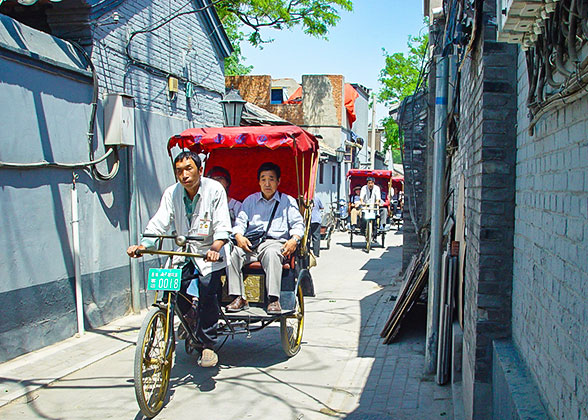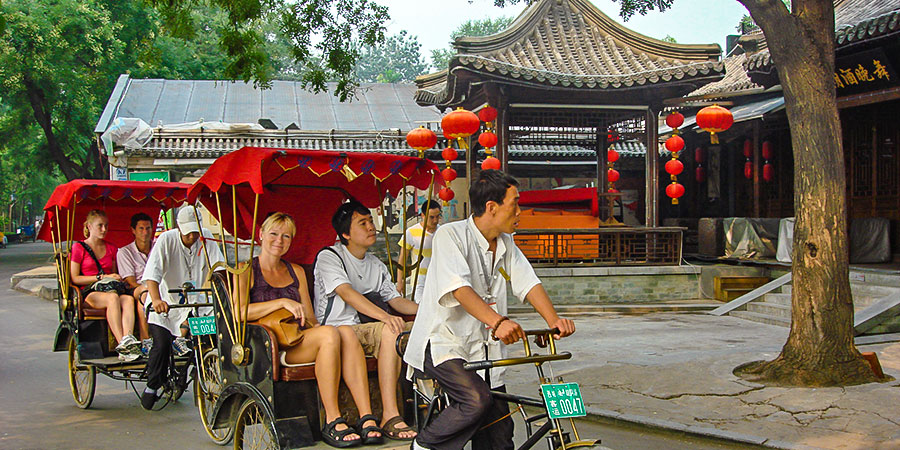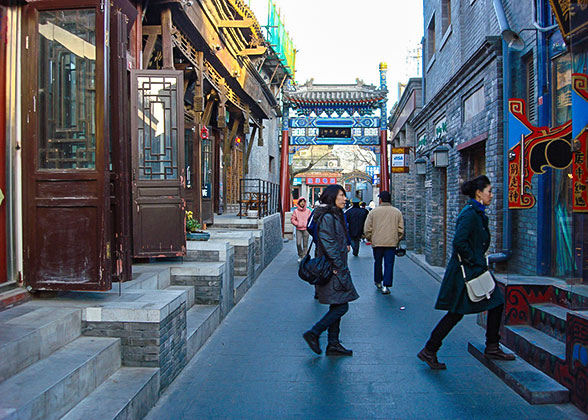Beijing Hutong
People say that the real culture of Beijing lies in the culture of Hutong and Siheyuan (courtyards). How true it is! They give an insight to the old lifestyle of ordinary Beijingers and have special appeal to tourists. As one of the most representative icons in local culture, Hutong Beijing is usually included in a classical tour itinerary there.
What is a Hutong in China?
Hutong is the name given to a narrow lane, alley, or small street between rows of single-storey Siheyuan dwelled by Beijingers in the past. When viewed from the air the interlaced lanes resemble a maze or a chessboard with delicate gardens, fine rockeries and ancient ruins which makes them a wonder in the world.
 |
More Beijing Tours |
In the past, Beijing has hundreds of courtyards around the Forbidden City, and the lanes between courtyards stretched out in all four directions, connecting the different kinds of courtyards in the city. Originally formed in the Yuan Dynasty (1271 - 1368), Hutongs welcomed their heyday during the Ming and Qing Dynasties (1368 - 1911), when the number significantly increased to 2,076. It is said that by 1949 there were as many as 3,250 Hutongs. But with the passage of time, and the requirement for city construction, the number of them has fallen dramatically. In 2003, only 1,500 were left, and now no more than 1,000 remain and a majority of the existing ones have been transformed into tourist attractions associated with street food, shopping, and bars. Thus, Hutong protection becomes an urgent issue for modern people.
|
|
Because of the interlacement of the lanes, every house is connected to the other, making it easy for local people to keep in touch with their neighbors. Therefore, once one enters any of the lanes, one can feel the deep and warm relationships among people, which is rarely found in this modern world.
In the twisted lanes one can experience the life of the locals. The public bathrooms and toilets can be found. Shops sell all kinds of goods that satisfy the local people's daily needs. It is just like a community. Gossiping in these lanes is a common scene as it is the main way for people to strengthen their relationship. These lanes have witnessed the development of Beijing. Where there is such a lane, there is a story.
|
|
How Does a Hutong Get Its Name?
The naming of Chinese Hutongs is very interesting. In ancient times the names were passed by word of mouth among people; there were no signposts. It was not until the Ming and Qing Dynasties that the names were written down gradually. Some Hutongs were named after the symbol construction in a lane, the local dialect, a person’s name and the location. For instance, Wangpi Hutong was named after the man Wang Pi. Guozijian Street was named so because Guozijian, the Imperial Academy is in the lane. In later years the government changed their original names into more formal ones, which sound more refined.
Of the more than 1,000 alleys left, there are ten most distinctive ones. Some of them are famous for the old-style buildings, while some house many traditional and time-honored workshops. Walking along the crisscrossing lanes, you will definitely immerse in the peaceful atmosphere.
![]() Nanluoguxiang (South Gong and Drum Lane)
Nanluoguxiang (South Gong and Drum Lane)
![]() Yandaixie Street (Yandai Xiejie)
Yandaixie Street (Yandai Xiejie)
![]() Dongjiaomin Lane (Dongjiaomin Xiang)
Dongjiaomin Lane (Dongjiaomin Xiang)
![]() Xijiaomin Lane (Xijiaomin Xiang)
Xijiaomin Lane (Xijiaomin Xiang)
![]() Ju'er Hutong
Ju'er Hutong
![]() Bada Hutong
Bada Hutong
Besides, there are still many less famous ones also worth a visit, such as Yichi Street - the shortest one, Jiuwan Hutong, with over 13 turnings, Lingjing Hutong - the widest one, and Dongsi Hutongs with many residences lived by celebrities.
Best Way to Explore Beijing Hutong - Join a Hutong Tour
 |
| Tourists traveling by rickshaw |
Beijing Hutong, as the soul of old Beijing, is the best place to experience local life. If you only have one day, the best option is to join a Hutong Tour. You will take a rickshaw and the driver will take you through the streets, narrow lanes and featured shops to experience the most authentic Beijing life!
How to get to Hutong Beijing
Shichahai and Dashilar are two areas where Hutongs abound. Visitors can take subway line 8 to Shichahai or subway line 2 or line 7 to Dashilar. Then you can hire a rickshaw to guide you to tour around nearby Hutongs.
See more:
Top 10 Cool Things to Do in Beijing for Youngsters
8 Interesting Places in Beijing You May Not Know
10 Fun Things to Do in Beijing with Family



